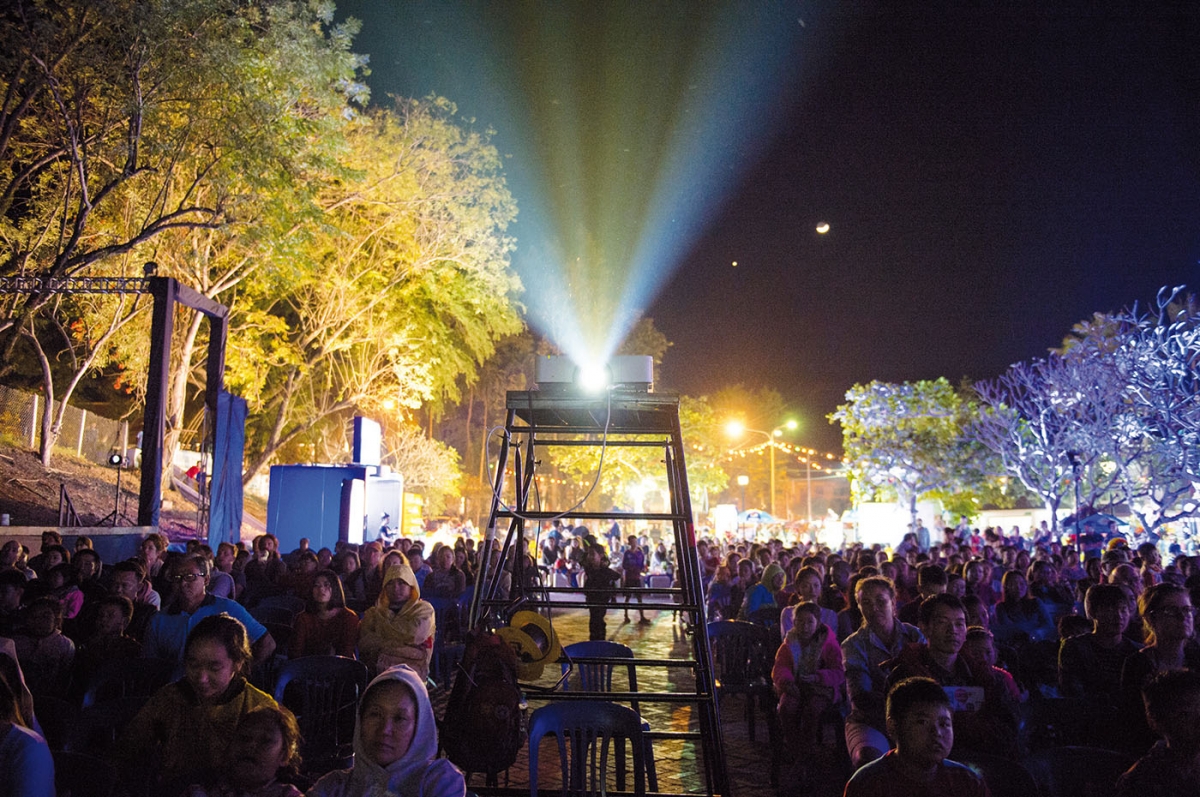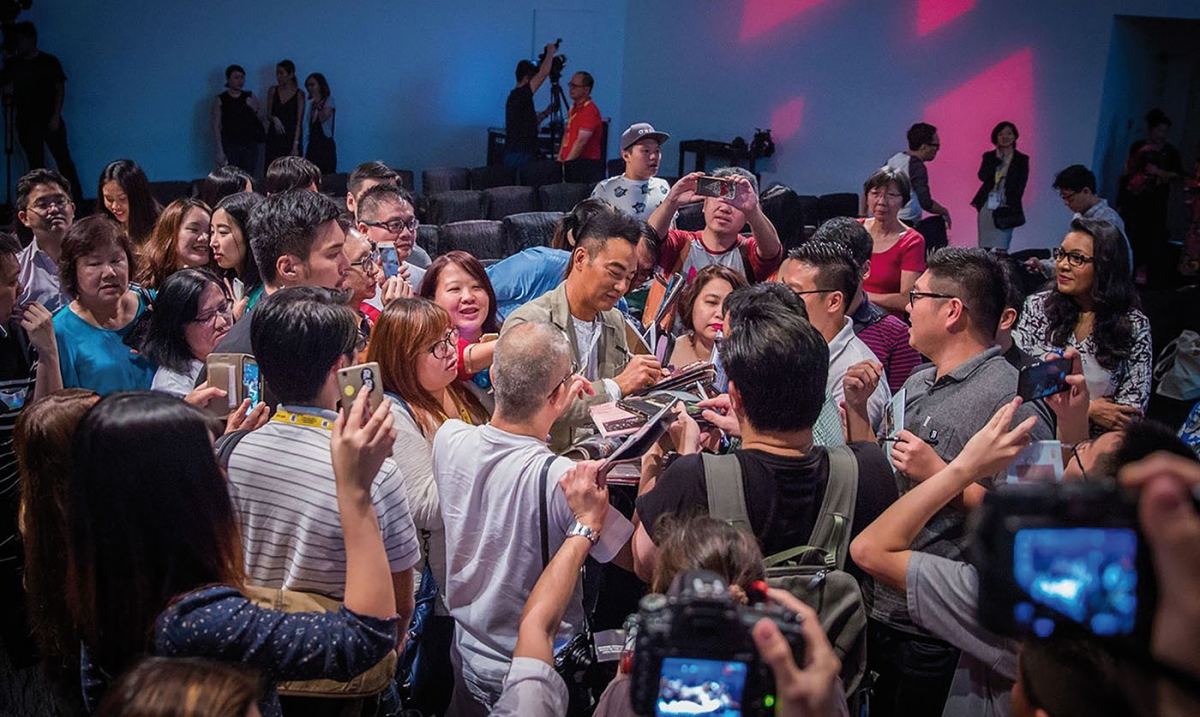Southeast Asian film festivals
<p>The start of this millennium has arguably seen a marked renaissance in the various national cinemas of Southeast Asia. The past few years have even brought a rise in production in the long moribund Cambodian film sector, and the beginnings of a filmmaking community in Laos, which has never had a film industry to speak of. The regionally-oriented film festival has emerged as a crucial factor in this broader resurgence not only of production but of local film cultures—in contexts where, in many instances, State or institutional support for film is lackluster.</p>
South Korea’s Busan International Film Festival, held annually (as are most all of the festivals discussed here) in early October, easily takes the mantle of Asia’s premier festival, in terms of its not just regional but global recognition and visibility, the volume and quality of its offerings (in both world cinema and Asian cinema, including many premieres), and the range of its programs to encourage film production in the broader Asian region. The festival often spotlights Southeast Asian films and artists, and such programs as the Festival’s Asian Film Academy and Asian Cinema Fund have provided vital mentoring and funding for emerging filmmakers from across Asia who in many instances cannot find such support in their home countries. Late October brings another major Asian festival with a partially regional (including Southeast Asian) emphasis, the Tokyo International Film Festival; although not as large or comprehensive in its programs as Busan, it does aim to support developing regional filmmakers for example through its ‘Asian Future Film Award’, given each year to a promising director from the region.
Another important Asian festival in this regard is the Hong Kong International Film Festival, a large-scale event founded in 1977, which usually screens more than 200 films in March to April of each year. The festival has developed a dual focus on world cinema and Asian cinema (mostly from Hong Kong, mainland China, and Japan, but with an occasional program highlighting a Southeast Asian nation); and it also facilitates Hong Kong co-production for films from across the region through its affiliated Hong Kong-Asia Film Financing Forum, an event in which a number of Southeast Asian filmmakers have participated over the years.
Yet while the global exposure (and support) offered through such festivals as these, as well as (for a successful few Southeast Asian filmmakers) such top Western festivals as those in Cannes, Berlin, Rotterdam and Toronto, can offer a major career boost, they do not do very much for developing the film culture in the respective filmmakers’ home countries, nor, in most cases, is there much targeted support for developing local Southeast Asian production—and it is in these areas that film festivals in and of the region can serve crucial functions. As Singapore International Film Festival Executive Director Yuni Hadi describes it, “We’ve seen our Southeast Asian filmmakers such as Lav Diaz (Philippines), Apichatpong Weerasethakul (Thailand), and most recently Anthony Chen and Boo Junfeng (Singapore) winning top awards at some of the best festivals in the world which helps put the spotlight on us, but it’s also very important to have our own film festivals to lead and not just to follow.”
A number of locally based festivals have developed to meet these local needs, while also publicizing local and regional production to a larger international audience, although they vary considerably in scale and robustness, often owing in no small part to a dearth of local funds to sustain them. Examples include the Hanoi International Film Festival (founded in 2010), the World Film Festival of Bangkok (begun in 2003), the Jogja-Netpac Asian Film Festival (in Yogyakarta, from 2006), the Cinemalaya Philippine Independent Film Festival (begun in 2005, in Manila), and the Cambodia International Film Festival (which started in Phnom Penh in 2010, but which had its 2016 (7th) edition postponed until March of the following year).
The model: Singapore
The Singapore International Film Festival (SGIFF, which had its first edition back in 1987) and the Luang Prabang Film Festival (LPFF, launched in 2010, in Laos) might appear to be at opposite ends of the Southeast Asian film festival spectrum, in terms of not only number of years in operation but also scale and approach, and yet a brief comparative look at the emphases of their 2016 editions (occurring in overlapping periods in late November to early December) highlights many shared central aims for such festivals. Undoubtedly the best known of Southeast Asia’s festivals, the SGIFF was long seen as exemplary for its promotion of film in the region and in fact the renowned Busan festival took the SGIFF as a model for its own development. And yet, even so established a festival as SGIFF recently ran into difficulties—a fact which testifies to the precariousness of support for local film cultures in the region, though certainly owing in part to internal struggles unique to itself. After a somewhat uneven 2011 event and a two-year hiatus, the festival came back strongly under new leadership in 2014 and has continued as a significant force in the two years since.1
Naturally one of the key aims of the SGIFF is to bring a wide array of films that otherwise might not be readily accessible to an audience composed both of local filmgoers and interested tourists and, given the festival’s high profile, many international critics and members of the industry as well. That international audience was fostered in 2016 with the SGIFF’s scheduling simultaneously with (and technically as a component part of) the Singapore Media Festival, a government sponsored industry event now in its third year with presentations and workshops on various media production and distribution trends within the region, as well as a market for sales of television and film productions. The SGIFF screened upwards of 160 films in this edition, in a variety of venues mostly in the central area of the city-state, including the newly renovated 1930 landmark Capital Theatre, local commercial cinemas, and the theaters of such cultural institutions as the National Museum of Singapore and the recently opened National Gallery Singapore.
This year’s screenings included a ‘Cinema Today’ section with films from across Europe, the Americas, and the Pacific; a program highlighting themes of hybridity in Latin-American cinema; and a special sidebar on Estonian animation. But the overwhelming emphasis was on Asian cinema, starting from the opening night red carpet gala screening (at the Marina Bay Sands) of Malaysian director Dain Said’s thriller Interchange. As Hadi explains, “The challenge in Southeast Asia is that our independent films often do well at international film festivals and then return home where it can be difficult to find an audience. The irony is that in many cases, the filmmaker is making the film for his or her own people. That’s why Asian-based film festivals and other alternative film spaces are important for giving these films exposure and also, where possible, putting them into context through dialogue sessions with the audience.” The 2016 SGIFF indeed put this into practice by having filmmakers and actors present at the screenings in many cases, to take questions from audience members immediately afterwards. Asian screening programs (of mostly fiction films, with a smattering of documentaries) included an Asian Feature Film Competition, a Southeast Asian Shorts Competition, a Singapore Panorama, a series of newly restored regional classics, and tributes to Japanese director Naomi Kawase and Hong Kong director Fruit Chan. The screenings emphasized the innovative art films one might expect at a festival, but also featured a healthy sampling of commercially-oriented genre films, in order (as Programme Director Wenjie Zhang explained) to fully reflect the diversity of production from the region.
As important to the festival as giving local exposure for Asian cinema of all varieties is the goal of fostering further, innovative film production within the region. This goal is approached through such programs as short masterclass sessions (open to public registration) with well-known Asian film directors, and panel discussions on such practical topics as (at the 2016 edition) seeking distribution in the present-day environment, working with actors, developing one’s screenplay, and using virtual reality tools. The SGIFF also organized two more extended development programs with local educational institutions: the Southeast Asian Film Lab, a week-long intensive workshop with established filmmaking mentors (held at LASALLE College of the Arts) for Southeast Asian filmmakers preparing to shoot their first feature films; and the Youth Jury & Critics Programme, a month-long series of workshops by professionals in the field for a group of developing young critics, mounted in conjunction with Nanyang Technological University.
The new blood: Luang Prabang
Back in 2010, Laos might have seemed a very unlikely place to start a film festival aiming to attract an international audience, given that only the faintest glimmer of a local production scene was evident in the country at that time. But it was precisely because of an evident lack of ways for a local film culture to develop there that it seemed to Gabriel Kuperman—an American with a background in media production and programming—that a film festival in Laos would offer many benefits to the community. Kuperman’s aims in founding the film festival in the popular tourist haven of Luang Prabang, therefore, were to provide an outlet to screen and publicize the bit of local production that was being done; to provide a space where Laotian and other Southeast Asian filmmakers and producers could interact, exchange ideas and information, and develop regionally-based projects; and also to provide local Luang Prabang (and tourist) audiences an opportunity to see the latest films coming out of the immediate region.
Some seven editions of the Luang Prabang Film Festival later, Kuperman still serves as its director, and it has developed as a major and much anticipated annual event for the town, gaining support over the years not only from the Lao government but also from a variety of corporate and NGO sponsors. Part of the LPFF’s distinctiveness, arising from its regionally specific aims, is in focusing solely on Southeast Asian film (taken to include not only films by Southeast Asian makers, but also films shot in the region); Kuperman indicates that this is the only major annual international-profile film festival that focuses exclusively on the region. Although on a much smaller scale than the SGIFF, in 2016 showing a total of 32 feature films (a slight increase over the past) along with a selection of shorts, the LPFF has its own distinctive challenges owing to its atypical setting. Perhaps most obviously, there has been the problem of a lack of any functioning film theater in the town. This was overcome most significantly by utilizing outdoor projection (appropriately, a Southeast Asian tradition) for the main nighttime screenings, which are free to the public and held in a historic, UNESCO-renovated market in the center of town—a market which has become the LPFF’s signature space (and the moveable plastic chairs that are used are now incorporated into the festival’s logo). For 2016, daytime screenings and events were held on the grounds of the five-star Sofitel Luang Prabang (a converted colonial governor’s residence), with feature screenings in one outbuilding with a maximum capacity of 100 viewers, an on-going selection of short films in another outbuilding, and public forums on film-related topics held on the garden lawn in between the two.
The obvious downside here is that the LPFF naturally does not offer the kind of technologically high-end screening experience some film purists would prefer. But the very significant upside (in addition to the huge public reach of the nighttime screenings, with an estimated 20,000 people present over the course of the week) is the unusually intimate scale of the daytime events, with filmmakers present at a majority of the screenings and available for extended discussions and interactions with audience members. This level of consistent and direct access to the filmmakers is rare for any film festival, and goes a long way to contributing to the LPFF’s goal of fostering connections and synergy among film artists and producers from the region. Thus, although Kuperman was quite pleased with an increase in international attendees in 2016 (evident in part in the need to turn people away from quite a few ‘full houses’ during the daytime screenings), he is wary of making the festival much larger, lest the intimate scale be lost.
As with the SGIFF, one of the goals, besides providing exposure for local film, is to provide support and assistance for local budding filmmakers. In 2016, this came in part through public forums and discussions with experts on such topics as pitching projects, distribution through ‘Video on Demand’ platforms, and the work of national film commissions. A selected group of young regional filmmakers were also invited to participate in a ‘Talent Lab’ led by New York’s well-known Tribeca Film Institute, with a top project from the group subsequently invited to participate in the Tribeca Film Institute Network Market in New York in 2017.
As to the feature films screened in 2016, these comprised a lively mix of contemporary and innovative fiction films and documentaries (with quite a few on controversial topics), chosen by a group of ‘Motion Picture Ambassadors’—film critics and producers from the region who make the picks for their respective home countries. Each year there is a special focus on one particular Southeast Asian country’s industry, and in 2016 the focus was on the Philippines, represented by such impressive films as Apocalypse Child (a drama about a surfing instructor rumored to have been fathered by a certain well-known American director when filming in the Philippines), Haze (which tells the story of the sad lives of a gang of street kids), and Ma’ Rosa (again focused on the difficulties faced by the poor, a film from the well-known director Brillante Mendoza).
Mutual aims
While the LPFF and the SGIFF might appear quite different in scale and locale, then, the commonality of their aims is evident. Such events have become vital means for getting the word out about new trends in Southeast Asian production; providing access to local audiences for the broader range of film output; fostering a measure of local film culture; offering training and mentorship opportunities for budding filmmakers; and facilitating dialogue as well as actual collaborations among film artists, producers, and distributors across the region.
Adam Knee, Professor of Film and Media Studies, University of Nottingham Ningbo China; Research Fellow, International Institute of Asian Studies, Leiden, NL (Adam.Knee@nottingham.edu.cn).


